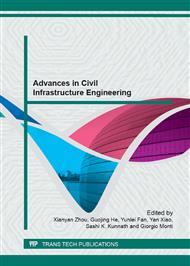[1]
H. J. Liu, Research on the nonlinear rheology and temperature effect of engineering polymers, Wuhan University of Technology, Wuhan, 2006. (in Chinese)
Google Scholar
[2]
S. P. He, Mechanical properties of polymers, second ed., Press of University of Science & Technology of China, Hefei, 2008, pp.1-2. (in Chinese)
Google Scholar
[3]
J. D. Ferry, Viscoelastic Properties of Polymers, Wiley, New York, 1970.
Google Scholar
[4]
W. B. Luo, T. Q. Yang, Stress relaxation behavior of solid polymers, J. Polymer Materials Science and Engineering. 2002, 18(20) 97-99. (in Chinese)
Google Scholar
[5]
P. A. O'Connell, G. B. McKenna, Large deformation response of poly cabonate: time-temperature, time-aging time and time-strain superposition, J. Polymer Engineering and Science. 1997, 37(9)1485-1495.
DOI: 10.1002/pen.11797
Google Scholar
[6]
W. B. Luo, S. Jazouli, T. Vu-Khanh, Modeling of nonlinear viscoelastic creep of polycarbonate, E-polymers, 2007, 17: 1-11. (in Chinese)
DOI: 10.1515/epoly.2007.7.1.191
Google Scholar
[7]
R. G. Zhao, C. Z. Chen, Q. W. Li, W. B. Luo, Effects of stress and physical ageing on nonlinear creep behavior of poly(methyl methacrylate), J. of Central South University of Technology. 2008,15(s1)563-567.
DOI: 10.1007/s11771-008-0426-8
Google Scholar
[8]
S. Jazouli, W. B. Luo, F. Brémand, Nonlinear creep behavior of viscoelastic polycarbonate, J. of Materials Science. 2006, 41(2)531-536.
DOI: 10.1007/s10853-005-2276-1
Google Scholar
[9]
R. A. Schapery, Nonlinear viscoelastic solids, Int. J. of Solids and Structures. 2000, 37:359-366.
DOI: 10.1016/s0020-7683(99)00099-2
Google Scholar
[10]
Z. Dobkowski, Thermal analysis techniques for characterization of polymer materials, J. Polymer Degradation and Stability, 2006, 91: 488-493.
DOI: 10.1016/j.polymdegradstab.2005.01.051
Google Scholar
[11]
H. Li, Research on rheological properties of room-temperature curing epoxy adhesive, Central South University of Forestry and Technology, Changsha, 2012. (in Chinese)
Google Scholar
[12]
E. N. da C. Andrade, On the viscous flow in the metals and allied phenomena, Proceeding of the Royals Society of London. 1910, 84A: 1-12.
Google Scholar
[13]
L. W. Yuan, Rheological mechanics, Science Press, Beijing, 1979, pp.97-98. (in Chinese)
Google Scholar


